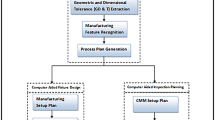One of the most difficult tasks we face in automated process planning is determination of operation sequencing. In this paper we present an approach to automatic generation of machining sequences in an object-oriented automated process planning system. Sequencing of machining operations is carried out in three phases of planning: initial planning, set-up planning, and final planning. The initial planning generates general plans including the required operations and machine cells. Two types of information are used at this stage, manufacturing process knowledge and component information, including features and associated dimensions, tolerances, surface finish, and material conditions. Based on process requirements decided in the initial planning, the set-up planning selects machines and fixtures, decides the clamping surfaces and feature accessibility, and sequences the set-ups. The final planning determines all the detailed sequences of operations based on the set-ups using the built-in manufacturing logic and heuristics. We introduce the set-up planning, the core of the planning system, to link the part model, initial planning and final detailed planning. The strategy has been implemented in an object-oriented process planning system. An example is provided to demonstrate the approach.
Similar content being viewed by others
References
Alting, L. and Zhang, H. (1989) Computer-aided process planning: the state-of-the-art survey. International Journal of Operation Research, 27(4), 553–585.
Chang, T. C. and Wysk, R. A. (1983) CAD/generative process planning with TIPPS. Journal of Manufacturing Systems, 2(2), 127–135.
Descotte, Y. and Latombe, J. C. (1984) GARI: An expert system for process planning, in Solid Modelling by Computers, Pickett, S. and Boyes, J. W. (eds), Plenum Press, NY, pp. 329–345.
Eversheim, W. and Fuchs, H. (1980) Integrated generation of drawings, process plans and NC tapes, in Advanced Manufacturing Technology, Black, P. (ed.), IFIP Conference, North-Holland, pp. 304–14.
Goldberg, A. and Robson, D. (1983) SmallTalk-80: The Language and Its Implementation, Addison-Wesley, Reading, MA.
Ham, I. and Lu, S. C.-Y. (1988) Computer-aided process planning: the present and the future. Annals of the CIRP, 37(2), 1–11.
Inui, M., Suzuki, H., Kimura, F. and Sata, T. (1987) Extending process planning capabilities with dynamic manipulation of product models in Proceedings of the 19th CIRP International Seminar on Manufacturing Systems, Computer-Aided Design Process Planning, pp. 273–280.
Iwata, K. (1987) Knowledge-based computer-aided process planning, in Intelligent Manufacturing Systems, II, 2nd International Seminar, pp. 3–25.
Joshi, S. B. and Chang, T. C. (1987) CAD interface for automated process planning, in Proc. of the 19th CIRP International Seminar on Manufacturing Systems, Computer-Aided Process Planning, pp. 39–45.
Kimura, F., Kawabe, S. and Sata, T. (1984) A study on product modelling for integration of CAD/CAM, in Integration of CAD/CAM, Kochan, D. (ed.), North-Holland, IFIP, pp. 227–244.
Kusiak, A. (1990) Process planning: A knowledge-based and optimization perspective. IEEE Transactions on Robotics and Automation, 7(3), pp. 257–266.
Matsushima, K., Okada, N. and Sata, T. (1982) The integration of CAD and CAM by application of artificial intelligence techniques. Annals of the CIRP, 31(1), pp. 329–332.
Peklenik, J., Grum, J. and Logar, B. (1985) An integrated approach to CAD/CAPP/CAM and group technology by pattern recognition. Manufacturing Systems, 14(1), 17–37.
Peklenik, J. and Sekolonik, R. (1990) Development of the part spectrum database for computer integrated manufacturing systems. Annals of the CIRP, 39(1), 471–474.
Piersol, K. W. (1987) HUMBLE Reference Manual, Xerox Special Information Systems, Vista Lab, Pasadena, CA.
Van't Erve, A. H. and Kals, H. J. J. (1986a) XPLANE, a generative computer-aided process planning for part manufacturing. Annals of the CIRP, 35(1), pp. 325–329.
Van't Erve, A. H. and Kals, H. J. J. (1986b) XPLANE, a knowledge-based driven process planning expert system, in Proceedings of International Conference on Computer-Aided Production Engineering, pp. 41–46.
Vogel, S. A. and Adlard, E. J. (1981) The AUTOPLAN process planning system, Presented at the 18th Numerical Control Society Technical Conference.
Wang, H. P. and Wysk, R. A. (1987) TURBO-CAPP: A knowledge-based computer-aided process planning system, in Proceedings of the 19th CIRP International Seminar on Manufacturing Systems, Computer-Aided Process Planning, pp. 161–169.
Wright, A. J., Darbyshire, I. L., Park, M. W. and Davies, B. J. (1987) EXCAP and ICAPP: integrated knowledge-based systems for process planning, in Proceedings of the 19th CIRP International Seminar on Manufacturing Systems, Computer-Aided Process Planning, pp. 309–13.
Zhang, Y., Gu, P. and Norrie, D. H. (1992) Object-oriented product model for cellular manufacturing, in Proceedings of the International Conference on Object-Oriented Manufacturing Systems, pp. 90–97.
Author information
Authors and Affiliations
Rights and permissions
About this article
Cite this article
Gu, P., Zhang, Y. Operation sequencing in an automated process planning system. J Intell Manuf 4, 219–232 (1993). https://doi.org/10.1007/BF00123966
Issue Date:
DOI: https://doi.org/10.1007/BF00123966




